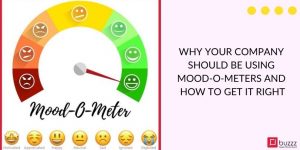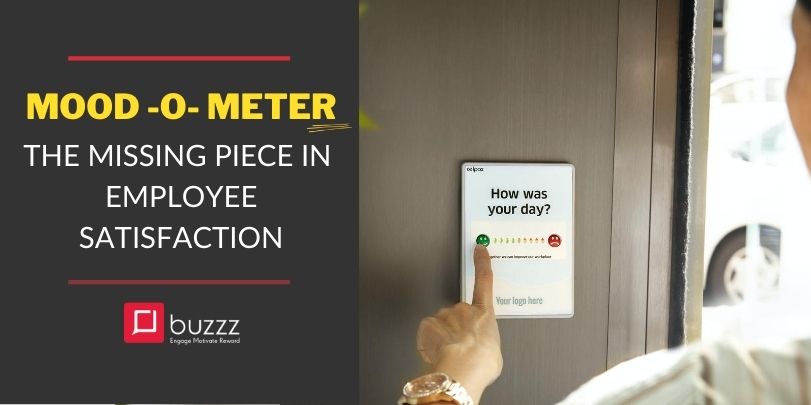MOOD-O-METER- The Missing Piece in Employee Satisfaction
Do companies with happier workforce outperform their peers financially? They absolutely do! And employee satisfaction is the secret sauce!
It’s almost too easy to imagine an army of satisfied and motivated employees posting stellar financial returns inside almost any company today. It is just as easy to imagine the opposite: A laggard employer struggling to turn a profit. Swiftly demotivated and unhappy under the oppressive burden of making profits for the company in a toxic environment.
In both scenarios, there is one common factor “employee satisfaction” which has driven a company to achieve new heights or bringing it to face losses! Thus making employee satisfaction a critical element of organizational success. So the pertinent question is – How does one then identify and leverage on this aspect!
MEASURING EMPLOYEE SATISFACTION
“Employee satisfaction” is the term used to describe whether employees are happy and fulfilling their expectations at work. Employee satisfaction is often treated as an intangible and abstract element of human resource management. Many large organisations spend hundreds of hours and thousands of rupees on anonymous employee satisfaction surveys that are administered periodically to gauge employee satisfaction. Some common aspects considered during an employee satisfaction survey are:
- Leadership Management
- Understanding of mission and vision
- Empowerment of employees
- Teamwork
- Communication
- Co-worker interaction
The facets of employee satisfaction measured vary from company to company. Alternatively, another method to measure employee satisfaction is meeting with small groups of employees and asking the same questions verbally. Depending on the size & culture of the company, and whether employees feel free to provide feedback, either method can contribute knowledge about the degree of employee satisfaction to managers and employees.
Despite all these multi-dimensional surveys and continuous feedback, there is still ONE MISSING PIECE, which usually disarms the best of efforts to create a satisfied workforce! Employee Happiness.
Over 1 million people call in sick every day due to work–related stress – Unanticipated absenteeism directly and indirectly related to workplace stress costs approximately $602 per worker per year, according to the American Institute of Stress.
WHY YOUR COMPANY SHOULD BE USING MOOD-O-METERS AND HOW TO GET IT RIGHT

The right way to engage employees and keep them happy essentially comes with actually LISTENING and analysing your employee’s moods and concerns. Surveys are effective, yet lack in completely discovering true employee emotions and addressing them to engage employees in organizational growth. That is exactly why every conventional and progressive leader needs to track employee moods. This is easily achievable with an agile employee engagement platform like Buzzz. This platform uses the Mood tracker survey to only ask questions proven to directly affect employee moods. Based on their response also gives them an option to share feedback and concern anonymously to avoid any possible backlash. This tool is effortless and always provide the most current and rounded feedback.
Let’s look at a recent case study of change directly spurred by feedback from a Mood-o-Meter survey:
In back to back reports, it was highlighted that the mood-o-meter recorded consistent negative or unhappy emotion across the team. This was flagged to the HR and CEO and they nudged the team leader to look into the issue. Upon probing the problem emerged where employees had a hard time disconnecting from a virtual meeting when other teammates were online. This included late working hours or working over weekends or on public holidays. The team leader also probed the manager to understand if any undue pressure was being added from the management’s end and prompting employees to work odd days or hours. Furthermore, the results showed that this practise was prevalent in multiple teams across the organization.
The management of the organization realised that in current times, having a break from work or truly switching off from work is critical for productivity and hence promptly announced 2 days of mandatory monthly off. During these 2 days, no employee was permitted to login or officiate any deals or attend calls unless extremely urgent. They did so to ensure that everyone can avoid complete burnout or unnecessary stress. They also implemented a rule of no working over long weekends. The next consecutive reports reflected the mood of the employees and also instilled faith in the management.
Here’s what a mood-o-meter can do for your organization.
- Keep a continuous pulse on your people –A study conducted in 2017 suggests that disengaged employees can cost their organizations $450 – $500 billion dollars in the long run. It is therefore in your best interest to keep employees invested and performing their best. Many organizations employ annual or semi-annual employee engagement surveys to get a better understanding of company pain points, concerns, and overall needs for their employees. While engagement surveys give you a great initial gauge of how all your employees feel, companies need a way to act on engagement data in real–time so employees feel like they’re being heard. To bridge those gaps between bigger surveys, you need a frequent pulse measurement among your employees. Tools like ‘Let’s Buzzz are an advanced employee pulse survey tool. It is built for recording employee experience and making the feedback process fast, easy, and actionable to get to the heart of any organizational issues. A Mood-O-Meter allows you to get a more continuous picture of the effectiveness of your employee engagement strategies. This, in turn, helps you get more frequent tracking of your employee engagement initiatives over time.
More information is less time – Neuroscience supports that happier employees do better on all fronts. Interactive bot and tools like ‘Let’s Buzzz’ with an in built ‘mood-o-meter’ helps assess employees’ state of mind. It asks simple questions like how are you feeling? And what is making you feel this way? To assess the extent of happiness among employees. In case it detects discontentment, it will notify the respective managers. For most organizations, engagement tracking comes only once or twice a year in the form of a long-form survey or performance review. With Gallup reporting that only 34% of workers are engaged in the workplace, HR is left struggling to find ways to address and bring up this percentage. Mood-o-Meter surveys can be administered as often as weekly, monthly or even daily. While annual engagement surveys can sometimes take up to 60 minutes, these surveys take no longer than 60 seconds and can give you a consistent insight into the progress of your specific initiatives. Work-related stress is termed as a ‘silent killer’ causing anxiety among Indian employees. Workplace anxiety causes low productivity and takes a toll on mental health. However, the mood-o-meter helps resolve these issues easily and effectively. And more importantly, you can receive the survey results in an easy-to-read, interactive dashboard and use that information to nudge corrective action.
ACTING ON THE FEEDBACK
If an employer decides to create a happy workplace, they are committing to making changes in the work environment based on the employee mood and their happiness quotient. Additionally, the employer is also committing to making changes to the work environment, with the help and involvement of employees and teams of employees.
Employee satisfaction is a shared responsibility and demands equal participation at the end of the employee as well. Unless the employees record their daily moods and offer genuine feedback and improvement suggestions true employee happiness is impossible to achieve.
Most employees don’t tired of giving feedback, they are tired of surveys and polls when they aren’t seeing action taken on the feedback. Tools like ‘Let’s Buzzz – an Employee Engagement and Appreciation platform offers an action plan to easily gather insights mapped to every individual in the organisation, thus helping leaders make an easy course correction. It also offers the option of anonymous us feedback. You can even share summaries of feedback with teams and pledge to take action or unveil a new initiative that is a direct result of the feedback.
Of course, there are times when you can’t easily move forward on certain bits of feedback. And, some things can take months to see successful execution. But even small wins or changes based on team feedback can have a larger ripple effect and help to improve employee happiness.
Amazing work cultures built on organizational trust don’t just spring up overnight. They come from amplifying employee voices and then making the right changes.
If you too wish to understand the pulse of your employees and engage them before it’s too late! Understand that MOOD-O-METER IS THE MISSING PIECE in employee satisfaction. It engages employees and leaders/managers into a system of ongoing and continuous feedback, thus allowing employees to feel satisfied and truly engaged.
Do you feel you need to do better at understanding your teams‘ happiness quotient and measure their contentment? Look no further- BOOK A DEMO WITH BUZZZ and experience true engagement today!

